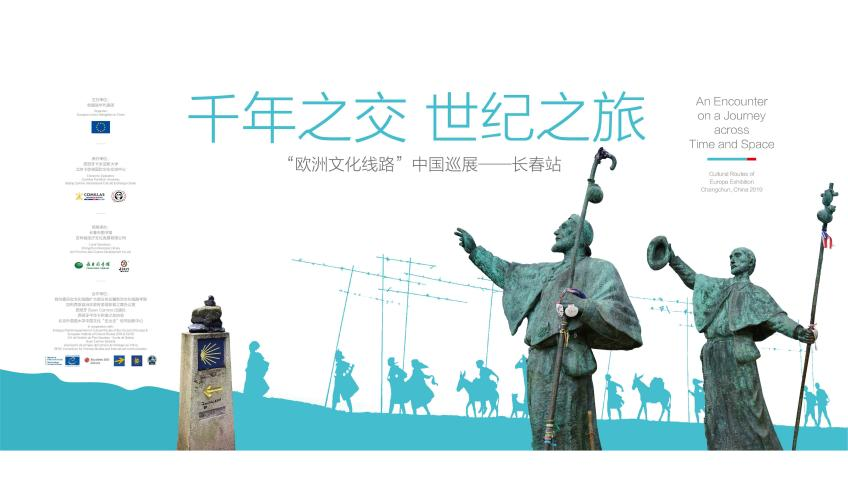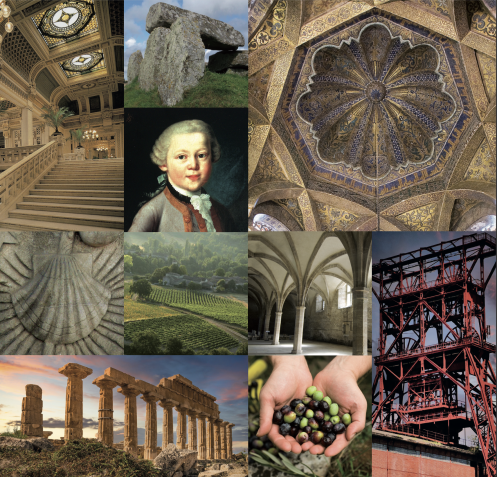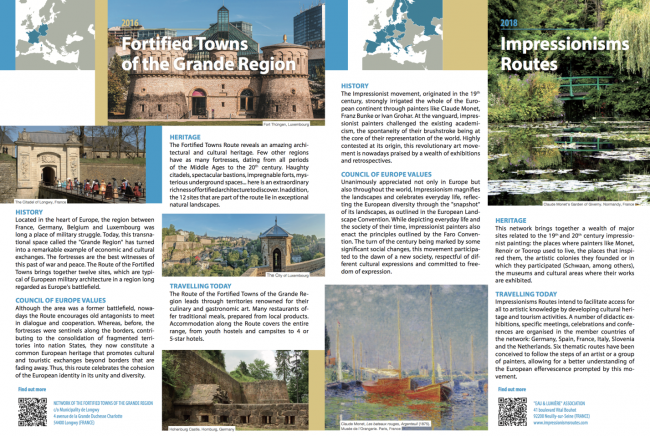| Cultural Routes of the Council of Europe Programme |
| PublishDate:2022-03-18 Hits:517 |
In 1987, with the revitalization of the Santiago de Compostela Pilgrim Route, the Council of Europe launched the Cultural Routes programme recognizing European space being criss-crossed by roads and paths of shared history and heritage which overcome distances, frontiers and language barriers.
The Cultural Routes of the Council of Europe, with thousands of sites across the continent, crisscross over 60 countries and counts, nowadays, 45 Routes, divided into different thematic clusters, including history and civilizations (such as the Prehistoric Rock Art Trails or the European Route of Jewish Heritage), arts and architecture (the Impressionisms Routes and Alvar Aalto Route), religious heritage (the European Route of Cistercian Abbeys, the Routes of Reformation), landscape and handicrafts (the European Route of Historic Gardens, the Route of the Olive, or the European Route of Ceramics), and industrial and scientific heritage (the European Route of Industrial Heritage or the Iron Route in the Pyrenees).
Through this programme, a model for transnational cultural and tourism management has been established which acts as a channel for intercultural dialogue involving national, regional, and local authorities and a wide range of associations and socio-economic actors. Moreover, Cultural Routes promote the partnership with universities and other research and academic institutions in the field of preservation and management of tangible and intangible heritage, tourism and regional development. Thus, most of the Routes also offer a wealth of educational activities.
Worth mentioning that 90% of Cultural Routes cross rural areas and promote lesser-known destinations, away from over-visited tourist sites. Therefore, the cultural tourism promoted by the routes is an important source of income and jobs that offer a valuable contribution to local and regional development. Notably, the programme endeavours to promote a form of tourism that supports the sustainable development of local communities while protecting and promoting rural landscapes and lesser-known European locations.
The European Institute of Cultural Routes (EICR) is the technical agency of the programme providing advice to the routes and candidate networks, organizing training, promoting visibility, and providing a system of signposting for the principal points on the itinerary. Every year, new applicants are awarded the certification “Cultural Route of the Council of Europe” which guarantees excellence. Evaluation is based on criteria such as: involving a theme that is representative of at least three different countries, being the subject of transnational and multidisciplinary scientific research, supporting cultural and educational exchanges for young people, developing exemplary projects in the field of cultural tourism and sustainable cultural development, etc. Applicants have to complete an articulated document dossier and every three years, Cultural Routes already certified are required to submit a report, and their activities are evaluated in order to ascertain whether they continue to satisfy the list of eligibility criteria.
The networks implement innovative activities and projects pertaining to five main priority fields of action: co-operation in research and development; enhancement of memory, history and European heritage; cultural and educational exchanges for young Europeans; foster contemporary artistic and cultural expression; cultural tourism and sustainable cultural development.
To promote cross-cultural exchange and sustainable tourism between China and Europe, in June 2019, the Director of the European Institute of Cultural Routes of the Council of Europe, Stefano Dominioni, participated at the UNESCO Conference in Meishan (Sichuan) on “Rural-Urban Development. The Future of Historic Villages and Towns” (see WHITRAP Newsletter no.45, pages 41-44) and in September 2020, an exhibition showcasing 38 Cultural Routes certified by the Council of Europe opened in Beijing. The event, entitled “An Encounter on a Journey across Time and Space - Cultural Routes of Europe Exhibition,” was organized by the Delegation of the European Union to China in cooperation with the EU National Institute for Culture (EUNIC) China Cluster and met with great interest in Chinese and European visitors.
 Poster of the exhibition “An Encounter on a Journey across Time and Space,” Changchun 2019 and Beijing 2020
© Cultural Routes of the Council of Europe
Collage of images promoting Cultural Routes of Europe © Cultural Routes of the Council of Europe
Two pages from the brochure promoting the Route of the Fortified Towns of the Grande Region and the Impressionisms Routes © Cultural Routes of the Council of Europe |
- News | WHITRAP Shanghai and CNR-ISPC bilateral meeting
- News | WHITRAP meets Cité de l’Architecture et du Patrimoine
- WHITRAP Hosting "Workshop on Preliminary Assessment for National Focal Points of the Asia Region" in Chengdu
- WHITRAP Shanghai meets UNESCO
- INTERNATIONAL CONFERENCE PRELIMINARY ANNOUNCEMENT & CALL FOR PAPERS
- Observation of the 46th Session of the World Heritage Committee
Copyright © 2009-2012 World Heritage Institute of Training and Research-Asia and Pacific (shanghai)




